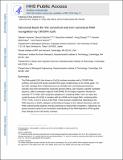| dc.contributor.author | Yamano, Takashi | |
| dc.contributor.author | Zetsche, Bernd | |
| dc.contributor.author | Ishitani, Ryuichiro | |
| dc.contributor.author | Zhang, Feng | |
| dc.contributor.author | Nishimasu, Hiroshi | |
| dc.contributor.author | Nureki, Osamu | |
| dc.date.accessioned | 2020-05-27T12:52:30Z | |
| dc.date.available | 2020-05-27T12:52:30Z | |
| dc.date.issued | 2017-08 | |
| dc.date.submitted | 2017-06 | |
| dc.identifier.issn | 1097-2765 | |
| dc.identifier.uri | https://hdl.handle.net/1721.1/125487 | |
| dc.description.abstract | The RNA-guided Cpf1 (also known as Cas12a) nuclease associates with a CRISPR RNA (crRNA) and cleaves the double-stranded DNA target complementary to the crRNA guide. The two Cpf1 orthologs from Acidaminococcus sp. (AsCpf1) and Lachnospiraceae bacterium (LbCpf1) have been harnessed for eukaryotic genome editing. Cpf1 requires a specific nucleotide sequence, called a protospacer adjacent motif (PAM), for target recognition. Besides the canonical TTTV PAM, Cpf1 recognizes suboptimal C-containing PAMs. Here, we report four crystal structures of LbCpf1 in complex with the crRNA and its target DNA containing either TTTA, TCTA, TCCA, or CCCA as the PAM. These structures revealed that, depending on the PAM sequences, LbCpf1 undergoes conformational changes to form altered interactions with the PAM-containing DNA duplexes, thereby achieving the relaxed PAM recognition. Collectively, the present structures advance our mechanistic understanding of the PAM-dependent, crRNA-guided DNA cleavage by the Cpf1 family nucleases. Keywords: CRISPR-Cas; Cas12a; Cpf1; crystal structure; protospacer adjacent motif | en_US |
| dc.description.sponsorship | NIMH (Grant 5DP1-MH100706) | en_US |
| dc.description.sponsorship | NIMH (Grant 1R01-MH110049) | en_US |
| dc.description.sponsorship | NIDDK (Grant 5R01DK097768-03) | en_US |
| dc.language.iso | en | |
| dc.publisher | Elsevier BV | en_US |
| dc.relation.isversionof | https://dx.doi.org/10.1016/j.molcel.2017.06.035 | en_US |
| dc.rights | Creative Commons Attribution-NonCommercial-NoDerivs License | en_US |
| dc.rights.uri | http://creativecommons.org/licenses/by-nc-nd/4.0/ | en_US |
| dc.source | PMC | en_US |
| dc.title | Structural Basis for the Canonical and Non-canonical PAM Recognition by CRISPR-Cpf1 | en_US |
| dc.type | Article | en_US |
| dc.identifier.citation | Yamano, Takashi et al. "Structural Basis for the Canonical and Non-canonical PAM Recognition by CRISPR-Cpf1." Molecular Cell 67, 4 (August 2017): P633-645.e3 © 2017 Elsevier Inc. | en_US |
| dc.contributor.department | Broad Institute of MIT and Harvard | en_US |
| dc.contributor.department | McGovern Institute for Brain Research at MIT | en_US |
| dc.contributor.department | Massachusetts Institute of Technology. Department of Brain and Cognitive Sciences | en_US |
| dc.contributor.department | Massachusetts Institute of Technology. Department of Biological Engineering | en_US |
| dc.relation.journal | Molecular Cell | en_US |
| dc.eprint.version | Author's final manuscript | en_US |
| dc.type.uri | http://purl.org/eprint/type/JournalArticle | en_US |
| eprint.status | http://purl.org/eprint/status/PeerReviewed | en_US |
| dc.date.updated | 2019-10-08T12:07:43Z | |
| dspace.date.submission | 2019-10-08T12:07:48Z | |
| mit.journal.volume | 67 | en_US |
| mit.journal.issue | 4 | en_US |
| mit.metadata.status | Complete | |
